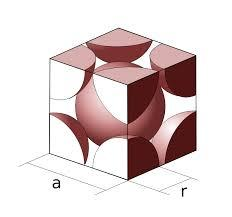
An element crystallizes in bcc structure. The edge length of its unit cell is 288 pm. If the density of the crystal is 7.2 g \[cm ^{- 3}\]. what is the atomic mass \[\;\left( {in{\text{ }}g/mol} \right)\] of the element?
A. 51.8
B. 103.6
C. 25.9
D. 207.2
Answer
219.3k+ views
Hint: Body-centered cubic unit cell is one kind of cubic lattice. In this cubic lattice each unit cell contains one atom at its body center. And contains one atom at the eight corners of the unit cell.
Formula used: Density = \[\dfrac{{(M \times z)}}{{(N \times {a^3})}}\]= \[\dfrac{{(molecular{\text{ }}weight){\text{ (}}number{\text{ }}of{\text{ }}atoms{\text{ }}per{\text{ }}cell){\text{ }}}}{{{{(edge{\text{ }}length)}^3}{\text{ (}}Avogadro{\text{ }}number)}}\]
Complete step by step answer:
The structure is shown below,

We know that,
Density = (mass)/(volume)
Applying this concept for calculating the density of the unite cell, we get,
Density = \[\dfrac{{(M \times z)}}{{(N \times {a^3})}}\]
= \[\dfrac{{(molecular{\text{ }}weight){\text{ (}}number{\text{ }}of{\text{ }}atoms{\text{ }}per{\text{ }}cell){\text{ }}}}{{{{(edge{\text{ }}length)}^3}{\text{ (}}Avogadro{\text{ }}number)}}\]
= \[7.2 = \dfrac{{M \times 2}}{{{{(288 \times {{10}^{10}})}^3} \times 6.022 \times {{10}^{23}}}}\]
Hence,
\[
7.2 = \dfrac{{M \times 2}}{{{{(288 \times {{10}^{10}})}^3} \times 6.022 \times {{10}^{23}}}} \\
M = \dfrac{{7.2 \times {{(288 \times {{10}^{10}})}^3} \times 6.022 \times {{10}^{23}}}}{2} \\
M = 51.77 \\
\]
Therefore, the molecular weight of the element is \[51.77gm/mol\].
Additional information:
In the B.C.C the closest distance between two atoms in the unit lattice is\[\dfrac{{\sqrt {\text{3}} a}}{2}\]. Where a is the edge length of the unit lattice.
Now according to this formula \[\dfrac{{\sqrt {\text{3}} a}}{{\text{2}}}{\text{ = 173pm}}\]
Therefore, the edge length is,
\[
\dfrac{{\sqrt {{\text{3a}}} }}{{\text{2}}}{\text{ = 173pm}} \\
{\text{a = }}\dfrac{{{{2 \times 173}}}}{{\sqrt {\text{3}} }} \\
{\text{a = 200pm}} \\
\]
Note: The contribution of each corner atoms is \[{\dfrac{{\text{1}}}{{\text{8}}}^{{\text{th}}}}\] of a total atom. So, the contribution of all eight atoms is, \[\dfrac{{\text{1}}}{{\text{8}}} \times 8 = 1\].
For the body center atoms, the contribution of that atom is a total of a total atom.
Total number of atoms is 2 in a B.C.C lattice.
Formula used: Density = \[\dfrac{{(M \times z)}}{{(N \times {a^3})}}\]= \[\dfrac{{(molecular{\text{ }}weight){\text{ (}}number{\text{ }}of{\text{ }}atoms{\text{ }}per{\text{ }}cell){\text{ }}}}{{{{(edge{\text{ }}length)}^3}{\text{ (}}Avogadro{\text{ }}number)}}\]
Complete step by step answer:
The structure is shown below,

We know that,
Density = (mass)/(volume)
Applying this concept for calculating the density of the unite cell, we get,
Density = \[\dfrac{{(M \times z)}}{{(N \times {a^3})}}\]
= \[\dfrac{{(molecular{\text{ }}weight){\text{ (}}number{\text{ }}of{\text{ }}atoms{\text{ }}per{\text{ }}cell){\text{ }}}}{{{{(edge{\text{ }}length)}^3}{\text{ (}}Avogadro{\text{ }}number)}}\]
= \[7.2 = \dfrac{{M \times 2}}{{{{(288 \times {{10}^{10}})}^3} \times 6.022 \times {{10}^{23}}}}\]
Hence,
\[
7.2 = \dfrac{{M \times 2}}{{{{(288 \times {{10}^{10}})}^3} \times 6.022 \times {{10}^{23}}}} \\
M = \dfrac{{7.2 \times {{(288 \times {{10}^{10}})}^3} \times 6.022 \times {{10}^{23}}}}{2} \\
M = 51.77 \\
\]
Therefore, the molecular weight of the element is \[51.77gm/mol\].
Additional information:
In the B.C.C the closest distance between two atoms in the unit lattice is\[\dfrac{{\sqrt {\text{3}} a}}{2}\]. Where a is the edge length of the unit lattice.
Now according to this formula \[\dfrac{{\sqrt {\text{3}} a}}{{\text{2}}}{\text{ = 173pm}}\]
Therefore, the edge length is,
\[
\dfrac{{\sqrt {{\text{3a}}} }}{{\text{2}}}{\text{ = 173pm}} \\
{\text{a = }}\dfrac{{{{2 \times 173}}}}{{\sqrt {\text{3}} }} \\
{\text{a = 200pm}} \\
\]
Note: The contribution of each corner atoms is \[{\dfrac{{\text{1}}}{{\text{8}}}^{{\text{th}}}}\] of a total atom. So, the contribution of all eight atoms is, \[\dfrac{{\text{1}}}{{\text{8}}} \times 8 = 1\].
For the body center atoms, the contribution of that atom is a total of a total atom.
Total number of atoms is 2 in a B.C.C lattice.
Recently Updated Pages
Is PPh3 a strong ligand class 12 chemistry JEE_Main

Full name of DDT is A 111trichloro22bispchlorophenyl class 12 chemistry JEE_Main

Sodium acetate on heating with soda lime produce A class 12 chemistry JEE_Main

Find the isoelectric point pI of Lysine A 556 B 974 class 12 chemistry JEE_Main

The order of basicity among the following compounds class 12 chemistry JEE_Main

The number of isomers in C4H10O are a7 b8 c6 d5 class 12 chemistry JEE_Main

Trending doubts
JEE Main 2026: Application Form Open, Exam Dates, Syllabus, Eligibility & Question Papers

Derivation of Equation of Trajectory Explained for Students

Hybridisation in Chemistry – Concept, Types & Applications

Understanding the Angle of Deviation in a Prism

Understanding Collisions: Types and Examples for Students

Understanding Atomic Structure for Beginners

Other Pages
NCERT Solutions For Class 12 Chemistry Chapter 1 Solutions - 2025-26

NCERT Solutions for Class 12 Chemistry Chapter Chapter 7 Alcohol Phenol and Ether

NCERT Solutions ForClass 12 Chemistry Chapter Chapter 8 Aldehydes Ketones And Carboxylic Acids

JEE Advanced Marks vs Ranks 2025: Understanding Category-wise Qualifying Marks and Previous Year Cut-offs

Haloalkanes and Haloarenes Class 12 Chemistry Chapter 6 CBSE Notes - 2025-26

Solutions Class 12 Chemistry Chapter 1 CBSE Notes - 2025-26




